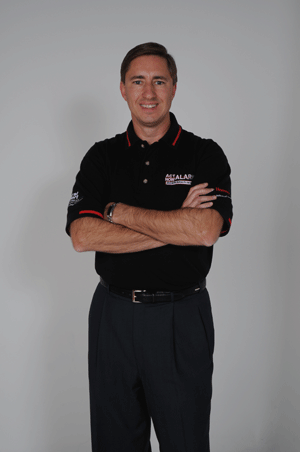
|
| Detroit officials wanted a false alarm solution sooner rather than later. So we told them about enhanced call verification, says Dean Belisle, long-time president of the Burglar and Fire Alarm Association of Michigan and vice president of Act Now Alarm. |
If you reassure Harriett Knight, you’ll be assured that, with a significant reduction in false alarms, the highest priority calls will get quicker response.
Knight, a supervisor in the 9-1-1 Detroit call center, says her operators receive more than 300 calls a day. She added the city’s recent commitment to enhanced call verification (ECV) through a partnership with local and national security industry leaders created a level of trust that has impacted the quality of police and emergency response on the city streets.
“Enhanced call verification is working,” Knight says. “It’s cut down on the number of calls. Call takers appreciate it. And it permits police and emergency responders to handle higher priority situations faster and better.”
The success of such false alarm fighting partnerships, including recent advances in Detroit and Eau Claire, Wis., are no easy accomplishments. They often involve the Security Industry Alarm Coalition (SIAC), state and local security organizations and businesses, city administrators, law enforcement officials and a whole lot of trust and focus. Procedures such as ECV along with educational efforts impacting alarm owners and central station operators are essential as well as complement the technology advances built into new-age alarm panels.
Crying wolf has been, and will be, around forever. Electronic burglar and fire alarms monitored by third parties, filtering and sending alarm information to police and fire agencies, makes critical sense. Add to that the pressure on these local agencies to tilt their response to higher priority situations and the attraction to generate revenue through alarm licensing fees and false alarm fines.
So it is not surprising that, in some communities, false alarms have been the perfect storm to dampen the effectiveness and growth of alarm monitoring.
However, in Detroit, the storm turned into a cooperative breeze of fresh air. Thanks in big part to Dean Belisle, long-time president of the Burglar and Fire Alarm Association of Michigan (BFAAM), and vice president of family owned Act Now Alarm.
It was a matter of personalities and expedience, observes Belisle. “A new mayor and a new chief of police. New faces. It is a testament to them. They wanted results,” he says. “The procedure change [of enhanced call verification] was faster than a policy change or changes in ordinances.” It also was a matter of trust. SIAC’s Glen Mowrey, a former deputy chief of police, came to Detroit and met with officials including Russell DeCrease, in charge of the Detroit 9-1-1 call center and who, according to Belisle, was initially skeptical of the security industry’s involvement and the potential of enhanced call verification.
Hard questions were answered. “We treated the city like a client,” says Belisle, about the need to set and maintain a trusting relationship with city and law enforcement officials. ECV is not the end. The city, with the help of local security businesses, is helping educate so-called false alarm “abusers,” and anticipated is an enhanced false alarm ordinance in the future. The strategy may be spreading outside Detroit, too, into suburban Troy and Novi, as examples.
In another private-public partnership, Belisle, with Karen Majeske, general manager at Guardian Alarm and a BFAAM director, works with call center management to recognize staff members on a regular basis based on their solid handling of calls.
Enhanced call verification is more than the traditional single call to the premises. It requires at least a second call to a cellular phone or alternative number or another method of audio/video verification. Without verification, there is no response, says Knight, who points out that no response is a form of education as some security monitoring firms and their clients catch on to what is expected.
Detroit Police Department Commander Todd Bettison, who sought a “hard and fast” solution, is pleased with the outcome of implementing ECV. “It’s a best practice,” and the city is handling 1,400 fewer calls than it would normally handle, after the procedural change in December. “It was doing the right thing to make things better right now. It was also an educational effort that continues,” Bettison says.
There are false-alarm-fighting success stories elsewhere.
For example, the Eau Claire, Wis., police department reports a dramatic decrease in calls for service thanks to a program developed with the Wisconsin Electronic Security Association (WIESA). Between 2005 and 2011, alarm dispatches dropped by 50 percent thanks to the implementation of proven strategies developed by SIAC and law enforcement agencies throughout the United States.
“Our mutual goal is for our community to benefit from the protection alarm systems afford, while at the same time making sure that police resources are used in the most effective manner to protect the community,” says Lt. Chad Hoyord. “This program has closed the gap for this objective.” In this case, the police department sends a letter to alarm users following a false alarm outlining the importance of operating the system correctly and the fees for repeat offenders. In addition, the police department requires ECV prior to dispatching officers.
“ECV is one of the most effective programs for identifying a system that has been accidentally activated,” adds WIESA member Dave Koenig. “It is a best practice that has shown dramatic results throughout the United States as alarm associations and police work together.”
“We have had excellent cooperation from our businesses, citizens, and alarm providers in this effort,” Hoyord says. “Our false alarms have been reduced by almost 30 percent from 2009 to 2010.”
Beyond enhanced call verification, there are numerous ways the security industry and local governments are contending with false alarms. Once a “be all,” video verification is “not an end all,” points out SIAC Executive Director Stan Martin. Joe Sanchez, senior vice president of customer operation for Protection 1, concurs. “Enhanced call verification has had immediate impact.” He adds that video verification may include judgment of what is going on.
There are limitations with any technology, procedures and solutions. “Someone has to pay,” points out Martin. In the long run, “it is a matter of education, simple procedures and an effective model ordinance.” Over the years, Martin and others in the industry have found that simpler solutions such as ECV are more effective and attractive to stakeholders.
Martin also points with pride to the improvements in the control panel, as highlighted by the ANSI SIA CP-01 2010 standards. “A few seconds can make a difference” when it comes to a false alarm, he says.
The CP-01 control panel standard deals with exiting, arming, entering and disarming. For instance, an extended time period is allowed for the user to exit or reenter a building before the alarm is activated. So when users are standing in the doorway fumbling for keys or checking for their cellular phone, they won’t set off the alarm. Plus, the audible exit annunciation sounder increases in frequency 10 seconds prior to final activation.
When people need to direct an alarm signal during emergencies, the CP-01 standard adds the simple step that requires two distinct actions be taken.
For duress alarm, a user can enter a unique code when under threat from an intruder, triggering a silent call for help. Industry feedback shows that the use of duress alarm deactivation is very rare, according to Martin. To make sure that a duress alarm is not accidentally activated, CP-01 requires that this duress code be programmed as a unique code that is not a variation of the main code.
There are other false alarm reduction aspects of the standard. It has been well received in the industry. According to Sanchez, his firm now only installs CP-01 compliant panels.




